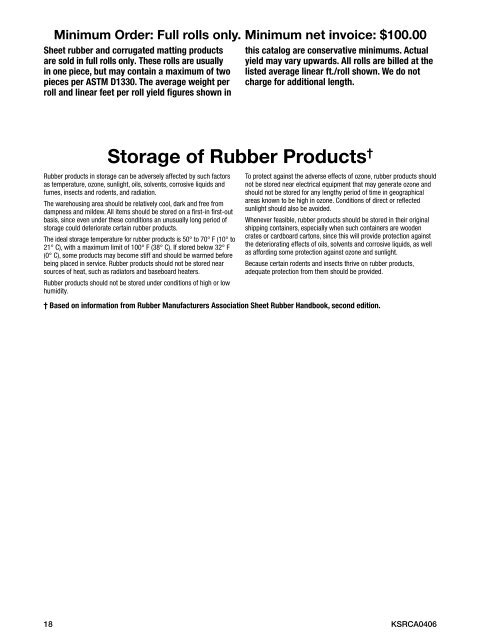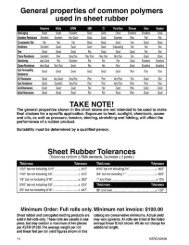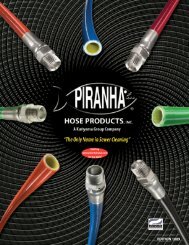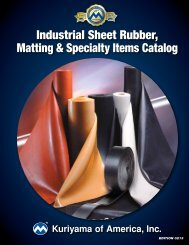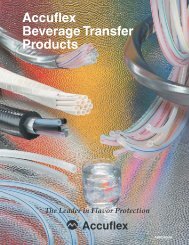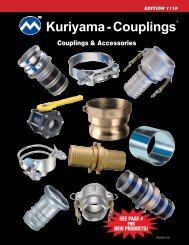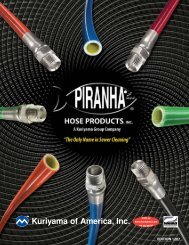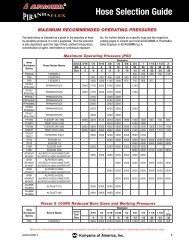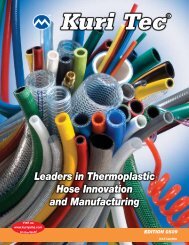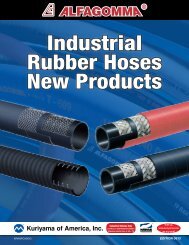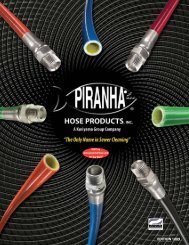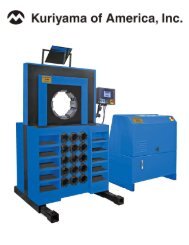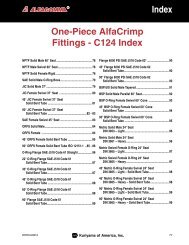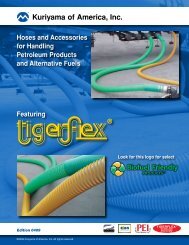Minimum Order: Full rolls only. Minimum net invoice: $100.00 Sheet rubber and corrugated matting products are sold in full rolls only. These rolls are usually in one piece, but may contain a maximum <strong>of</strong> two pieces per ASTM D1330. The average weight per roll and linear feet per roll yield figures shown in this catalog are conservative minimums. Actual yield may vary upwards. All rolls are billed at the listed average linear ft./roll shown. We do not charge for additional length. Storage <strong>of</strong> Rubber Products † Rubber products in storage can be adversely affected by such factors as temperature, ozone, sunlight, oils, solvents, corrosive liquids and fumes, insects and rodents, and radiation. The warehousing area should be relatively cool, dark and free from dampness and mildew. All items should be stored on a first-in first-out basis, since even under these conditions an unusually long period <strong>of</strong> storage could deteriorate certain rubber products. The ideal storage temperature for rubber products is 50° to 70° F (10° to 21° C), with a maximum limit <strong>of</strong> 100° F (38° C). If stored below 32° F (0° C), some products may become stiff and should be warmed before being placed in service. Rubber products should not be stored near sources <strong>of</strong> heat, such as radiators and baseboard heaters. Rubber products should not be stored under conditions <strong>of</strong> high or low humidity. To protect against the adverse effects <strong>of</strong> ozone, rubber products should not be stored near electrical equipment that may generate ozone and should not be stored for any lengthy period <strong>of</strong> time in geographical areas known to be high in ozone. Conditions <strong>of</strong> direct or reflected sunlight should also be avoided. Whenever feasible, rubber products should be stored in their original shipping containers, especially when such containers are wooden crates or cardboard cartons, since this will provide protection against the deteriorating effects <strong>of</strong> oils, solvents and corrosive liquids, as well as affording some protection against ozone and sunlight. Because certain rodents and insects thrive on rubber products, adequate protection from them should be provided. † Based on information from Rubber Manufacturers Association Sheet Rubber Handbook, second edition. 18 KSRCA0406
Terms, Conditions & Limited Warranty <strong>of</strong> Sale This document sets forth the terms and conditions pursuant to which the purchaser (“Purchaser”) will purchase and <strong>Kuriyama</strong> <strong>of</strong> <strong>America</strong>, Inc. (“Seller”) will sell the products, accessories and attachments (collectively the “Products”) ordered by Purchaser. These terms and conditions shall govern and apply to the sale <strong>of</strong> Seller’s Products to Purchaser, regardless <strong>of</strong> any terms and conditions appearing on any purchase order or other forms submitted by Purchaser to Seller, or the inconsistency <strong>of</strong> any terms therein and herein. 1. GENERAL ■ All orders are subject to a minimum charge <strong>of</strong> $100.00. ■ Any back ordered items totaling less than $100.00 minimum may be cancelled by Seller. ■ Seller reserves the right at all times to reject any and all orders for any reason. ■ Orders for other than standard items or standard lengths, may not be cancelled after purchase has been committed, production scheduled or any other costs incurred. 2. PRICE All prices set forth on any purchase order or other document are F.O.B. Sellers facility or distribution point, as may be determined by Seller (“F.O.B. Point”). All prices are exclusive <strong>of</strong> any and all taxes, including, but not limited to, excise, sales, use, property or transportation taxes related to the sale or use <strong>of</strong> the Products, now or hereafter imposed, together with all penalties and expenses. Purchaser shall be responsible for collecting and/or paying any and all such taxes, whether or not they are stated in any invoice for the Products. Unless otherwise specified herein, all prices are exclusive <strong>of</strong> inland transportation, freight, insurance and other costs and expenses relating to the shipment <strong>of</strong> the Products from the F.O.B. point to Purchaser’s facility. Any prepayment by Seller <strong>of</strong> freight insurance and other costs shall be for the account <strong>of</strong> Purchaser and shall be repaid to Seller. 3. PAYMENT TERMS Payment terms are as follows: ■ 2% 10 days (to approved and qualified accounts), Net 30 days. This is a cash discount for invoices paid within 10 days after the invoice date, regardless <strong>of</strong> date <strong>of</strong> receipt <strong>of</strong> shipment. This is not a trade discount and will not be granted to accounts that do not adhere to stated terms. ■ Notwithstanding the provisions <strong>of</strong> paragraph 16(b) below, Seller reserves the right to alter payment terms. ■ Seller reserves the right to hold shipments against past due accounts. ■ All past due accounts are subject to a late payment charge <strong>of</strong> 1.5% per month, or maximum allowed by law if different, along with the expenses incidental to collection including reasonable attorney’s fees and costs. 4. FREIGHT TERMS All shipments will be made F.O.B. shipping point as designated in these Terms & Conditions, and title shall pass at the F.O.B. point. Delivery to the initial common carrier shall constitute delivery to the Purchaser. Any claims for loss or damage during shipment are to be filed with carrier by the Purchaser. Seller will not assume responsibility for the performance <strong>of</strong> the carrier. ■ Freight prepaid on $3,000.00 net invoice on all combined products <strong>of</strong> Seller. Applies to Continental USA (48 states). ■ Freight prepaid on $7,500.00 net invoice orders consisting only <strong>of</strong> interlocked metal hose products. Applies to Continental USA (48 states). ■ Freight prepaid on $1,000.00 net invoice on couplings, accessories and hydraulic fittings only, excluding any PVC hose, metal hose, tubing products, and industrial, hydraulic and sheet rubber products. Applies to Continental USA (48 states). ■ Orders with different numbers and dates may not be combined to make freight allowance. ■ Orders placed at different warehouse locations may not be combined to make freight allowance. ■ Backorders will be shipped in the most practical fashion with charges consistent with our freight policy established with the original order. 5. UPS SHIPMENTS A handling charge, in accordance with current UPS regulations, will apply to any article that is not fully encased in an outside shipping container. Minimum charge for a package measuring over 84 inches in length and girth combined will be equal to the charge <strong>of</strong> a package weighing 30 lbs. plus the handling charge. This applies to all UPS air and surface transportation. 6. DROP SHIPMENTS Drop shipping is not a service usually <strong>of</strong>fered by Seller. If a drop shipment is made, a drop ship charge may be assessed. 7. DELIVERY, DAMAGES, SHORTAGES Seller shall use reasonable efforts to attempt to cause the Products to be delivered as provided for in these Terms & Conditions. Delivery to the initial common carrier shall constitute the delivery to the Purchaser. Seller’s responsibility, ins<strong>of</strong>ar as transportation risks are concerned ceases upon the delivery <strong>of</strong> the Products in good condition to such carrier at the F.O.B. point and all the Products shall be shipped at the purchaser’s risk. Seller shall not be responsible or liable for any loss or damage whatsoever, including loss <strong>of</strong> income and/or pr<strong>of</strong>its, or incidental, special, consequential damages resulting from Seller’s delayed performance in shipment and delivery. 8. RETURN OF DEFECTIVE PRODUCTS Defective or failed material shall be held at the Purchaser’s premises until authorization has been granted by Seller to return or dispose <strong>of</strong> Products. Products that are to be returned for final inspection must be returned Freight Prepaid in the most economical way. Credit will be issued for material found to be defective upon Seller’s inspection based on prices at time <strong>of</strong> purchase. 9. PRODUCTS ORDERED IN ERROR Standard package Products only may be returned, provided that claim is made and Seller is notified within 7 days <strong>of</strong> receipt <strong>of</strong> Products, and the Products are in the original buyer’s possession not more than 30 days prior to return, subject to Seller’s approval. If Products are accepted for return, they must be Freight Prepaid, and buyer will be charged a minimum <strong>of</strong> 15% rehandling charge, plus a chargeback for outbound freight charges if the original order was shipped prepaid. Returns are not accepted for any Products that are specially manufactured to meet the buyer’s requirement <strong>of</strong> either <strong>specifications</strong> or large quantity. 10. PRODUCTS SHIPPED IN ERROR Purchaser must notify within 7 days <strong>of</strong> receipt <strong>of</strong> Product any Products shipped in error. Upon notification, Products are to be returned to Seller either via truck on a Freight Collect basis, or via UPS on a Freight Prepaid basis. Purchaser will be reimbursed for cost <strong>of</strong> Products, plus any additional freight which may have been incurred due to shipping error. 11. SECURITY INTEREST Purchaser hereby grants to Seller and Seller hereby retains a continuing purchase money security interest in the Products sold and delivered by Seller to Purchaser, whether presently in the possession <strong>of</strong> Purchaser or hereafter acquired, and all spare parts and components therefore, together with any and all proceeds <strong>of</strong> sale or other disposition <strong>of</strong> the Products, including, but not limited to, cash, accounts, contract rights and chattel paper. Purchaser shall keep the Products free from any adverse lien, security interest or encumbrance and will not store the Products or any part there<strong>of</strong> or use the Products in violation <strong>of</strong> any statute or ordinance. In the event Purchaser shall be in default under these terms and conditions, Seller shall have the remedies <strong>of</strong> a secured party under the Uniform Commercial Code in force in the state where the Products are located. 12. CAUTIONARY STATEMENT All Products sold and distributed by <strong>Kuriyama</strong> <strong>of</strong> <strong>America</strong>, Inc. are in the nature <strong>of</strong> commodities and they are sold by published <strong>specifications</strong> and not for particular purposes, uses or applications. Purchaser shall first determine their suitability for the intended purposes, uses or applications and shall either conduct its own engineering studies or tests, or retain qualified engineers, consultants or testing laboratories and consult with them before determining the proper use, suitability or propriety <strong>of</strong> the merchandise or Products for the intended purposes, uses or applications. <strong>Kuriyama</strong> <strong>of</strong> <strong>America</strong>, Inc. (“Seller”) does not recommend the Products for any particular purpose, use or application, and the Purchaser or user there<strong>of</strong> shall assume full responsibility for the suitability, propriety, use and application <strong>of</strong> the Products. Purchaser shall follow all instructions contained in Seller’s catalogs, brochures, technical bulletins and other documents regarding the Products. The Products, including but not limited to, hose, tubing or couplings, may fail due to the use or conveyance <strong>of</strong> substances at elevated or lowered temperatures or at excessive pressure, the conveyance <strong>of</strong> abrasive, injurious, flammable, explosive or damaging substances. Hose or tubing used in bent configurations will be subjected to increased abrasion. Hose clamps or couplings may loosen after initial installation and all sections <strong>of</strong> hose and tubing including connections, couplings, clamps, conductivity and bonding should be inspected frequently, regularly and consistently, and should be replaced, adjusted or re-tightened for the avoidance <strong>of</strong> leakage, for the prevention <strong>of</strong> injuries or damages, and for general safety purposes. Except as indicated in its Limited Warranty, Seller shall not be liable or responsible for direct or indirect injuries or damages caused by or attributed to the failure or malfunction <strong>of</strong> any Products sold or distributed by it. Purchasers or users <strong>of</strong> the Products should frequently and consistently undertake inspections and protective measures with respect to the use and application <strong>of</strong> Products, which should include the examination <strong>of</strong> tube and cover, conditions <strong>of</strong> the hose or tubing, and the identification, repair or replacement <strong>of</strong> sections showing cracking, blistering, separations, internal and external abrasions, leaking or slipped couplings or connections and make proper pro<strong>of</strong> tests. 13. LIMITED WARRANTY The Products sold or distributed by Seller are warranted to its customers to be free from defects in material and workmanship at the time <strong>of</strong> shipment by us, subject to the following provisions. ALL WARRANTY CLAIMS SHALL BE MADE WITHIN SIX (6) MONTHS AFTER SELLER SHIPPED THE PROD- UCTS. SELLER’S LIABILITY HEREUNDER IS LIMITED AT SELLER’S EXCLUSIVE DISCRETION, TO 1) THE PURCHASE PRICE OF ANY PRODUCTS PROVING DE- FECTIVE; 2) REPAIR OF ANY DEFECTIVE PRODUCT OR PART THEREOF; OR 3) REPLACEMENT OF ANY DE- FECTIVE PRODUCT OR PART UPON ITS AUTHORIZED RETURN TO SELLER. THIS WARRANTY IS IN LIEU OF AND EXCLUDES ALL OTHER WARRANTIES, EXPRESSED, IMPLIED, STATU- TORY, OR OTHERWISE CREATED UNDER APPLICABLE LAW INCLUDING, BUT NOT LIMITED TO, THE WAR- RANTY OF MERCHANTABILITY AND THE WARRANTY OF FITNESS FOR A PARTICULAR PURPOSE. IN NO EVENT SHALL SELLER OR THE MANUFACTURER OF THE PRODUCT BE LIABLE FOR SPECIAL, INCIDEN- TAL, OR CONSEQUENTIAL DAMAGES, INCLUDING LOSS OF PROFITS, WHETHER OR NOT CAUSED BY OR RESULTING FROM THE NEGLIGENCE OF SELLER AND/OR THE MANUFACTURER OF THE PRODUCT, UNLESS SPECIFICALLY PROVIDED HEREIN. IN ADDI- TION, THIS WARRANTY SHALL NOT APPLY TO ANY PRODUCTS OR PORTIONS THEREOF WHICH HAVE BEEN SUBJECTED TO ABUSE, MISUSE, IMPROPER INSTALLATION, MAINTENANCE, OR OPERATION, ELECTRICAL FAILURE OR ABNORMAL CONDITIONS, AND TO PRODUCTS WHICH HAVE BEEN TAMPERED WITH, ALTERED, MODIFIED, REPAIRED, REWORKED BY ANYONE NOT APPROVED BY SELLER, OR USED IN ANY MANNER INCONSISTENT WITH THE PROVISIONS OF THE “CAUTIONARY STATEMENT” ABOVE OR ANY INSTRUCTIONS OR SPECIFICATIONS PROVIDED WITH OR FOR THE PRODUCT. 14. FORCE MAJEURE Seller’s obligation hereunder are subject to, and Seller shall not be held responsible for, any delay or failure to make delivery <strong>of</strong> all or any part <strong>of</strong> the Product due to labor difficulties, fires, casualties, accidents, acts <strong>of</strong> the elements, acts <strong>of</strong> God, transportation difficulties, delays by a common carrier, inability to obtain Product, materials or components or qualified labor sufficient to timely perform part <strong>of</strong> or all <strong>of</strong> the obligations contained in these terms and conditions, governmental regulations or actions, strikes, damage to or destruction in whole or part <strong>of</strong> manufacturing plant, riots, terrorist attacks or incidents, civil commotions, warlike conditions, flood, tidal waves, typhoon, hurricane, earthquake, lightning, explosion or any other causes, contingencies, or circumstances within or without the United States not subject to the Seller’s control which prevent or hinder the manufacture or delivery <strong>of</strong> the Products or make the fulfillment <strong>of</strong> these terms and conditions impracticable. In the event <strong>of</strong> the occurrence <strong>of</strong> any <strong>of</strong> the foregoing, at the option <strong>of</strong> Seller, Seller shall be excused from the performance under these Terms and Conditions, or the performance <strong>of</strong> the Seller shall be correspondingly extended. 15. GOVERNING LAW, JURISDICTION, VENUE AND WAIVER OF TRIAL BY JURY Except for the perfection <strong>of</strong> any security interest or lien in any other state, and except as otherwise provided herein, these terms and conditions will be governed and construed in all respects by the Internal laws and decisions, other than any conflict <strong>of</strong> laws provisions, <strong>of</strong> the State <strong>of</strong> Illinois, including, without limitation, all matters <strong>of</strong> construction, validity, enforceability, and performance. PURCHASER (I) CONSENTS AT SELLER’S ELECTION AND WITHOUT LIMITING SELLER’S RIGHT TO COMMENCE AN ACTION IN ANY OTHER JURIS- DICTION, TO THE EXCLUSIVE JURISDICTION AND VENUE OF ANY COURT (FEDERAL, STATE, OR LOCAL) SITUATED IN THE STATE OF ILLINOIS; (II) WAIVES ANY OBJECTION TO IMPROPER VENUE AND FORUM NON-CONVENIENS; AND (III) CONSENTS TO SERVICE OF PROCESS BY CERTIFIED MAIL, POSTAGE PREPAID, ADDRESSED TO PURCHASER AT ITS ADDRESS AS SET FORTH HEREIN. PURCHASER HEREBY WAIVES TRIAL BY JURY. Purchaser shall bring any action arising out <strong>of</strong> the sale <strong>of</strong> Products by Seller only in the federal or state courts in the State <strong>of</strong> Illinois. In the event Purchaser institutes any action in any court other than a court located in the State <strong>of</strong> Illinois, Purchaser shall assume all <strong>of</strong> Seller’s costs in transferring said proceeding to a court located in the State <strong>of</strong> Illinois, including, without limitation, reasonable attorneys’ fees. 16. MISCELLANEOUS (a) These terms and conditions constitute the entire agreement between Seller and Purchaser as it relates to terms and conditions <strong>of</strong> sale, and supersedes any and all prior oral or written agreements, correspondence, quotations or understandings heret<strong>of</strong>ore in force between the parties relating to the subject matter here<strong>of</strong>. There are no agreements between Seller and Purchaser with respect to the Product herein except those specifically set forth in and made part <strong>of</strong> these terms and conditions. Any additional terms, conditions and/or prices are rejected by Seller. (b) These terms and conditions may be modified, canceled or rescinded only by a written agreement <strong>of</strong> both parties executed by their duly authorized agents. 9/2005 KSRCA0406 <strong>Kuriyama</strong> <strong>of</strong> <strong>America</strong>, Inc. 19


